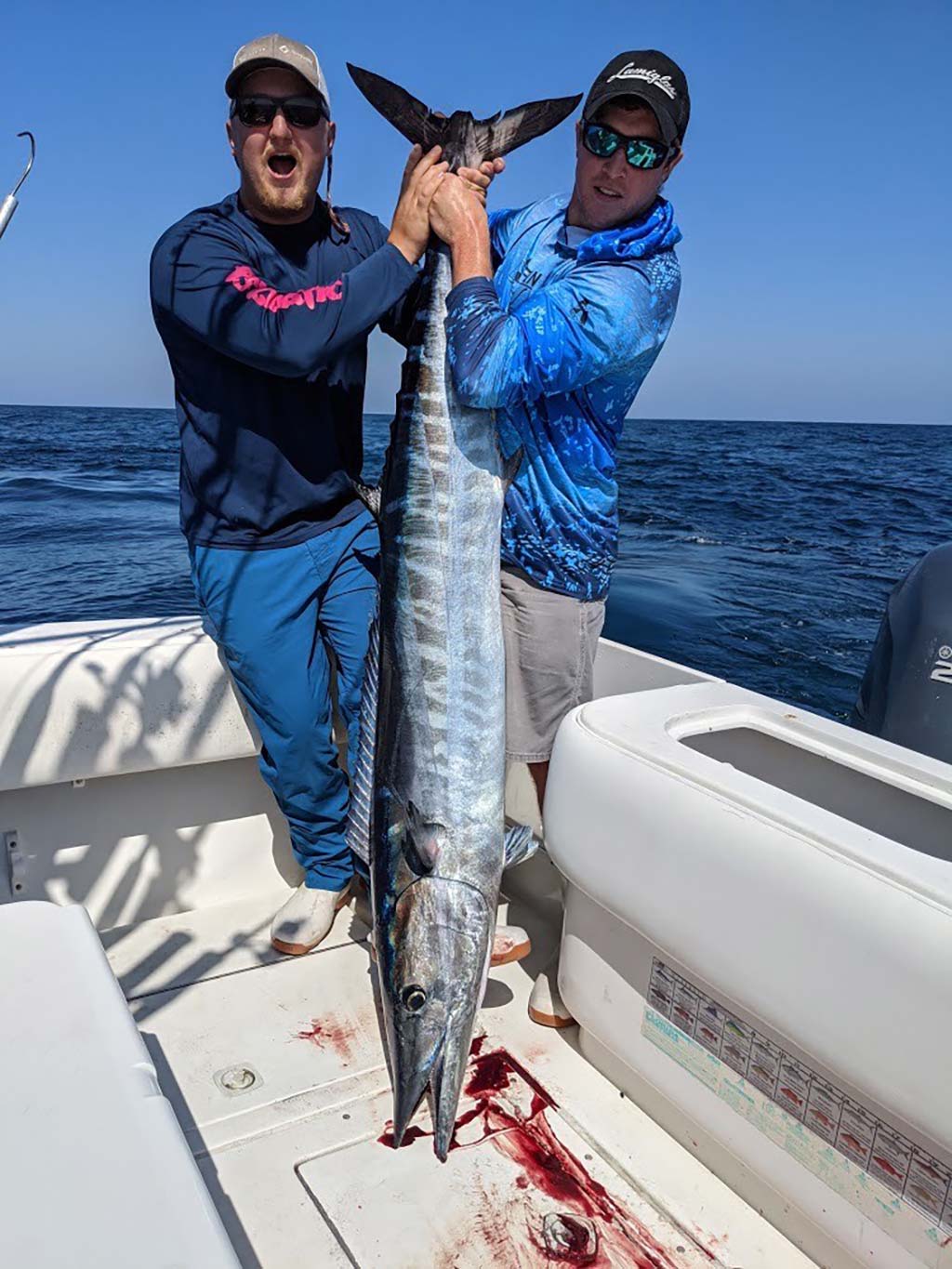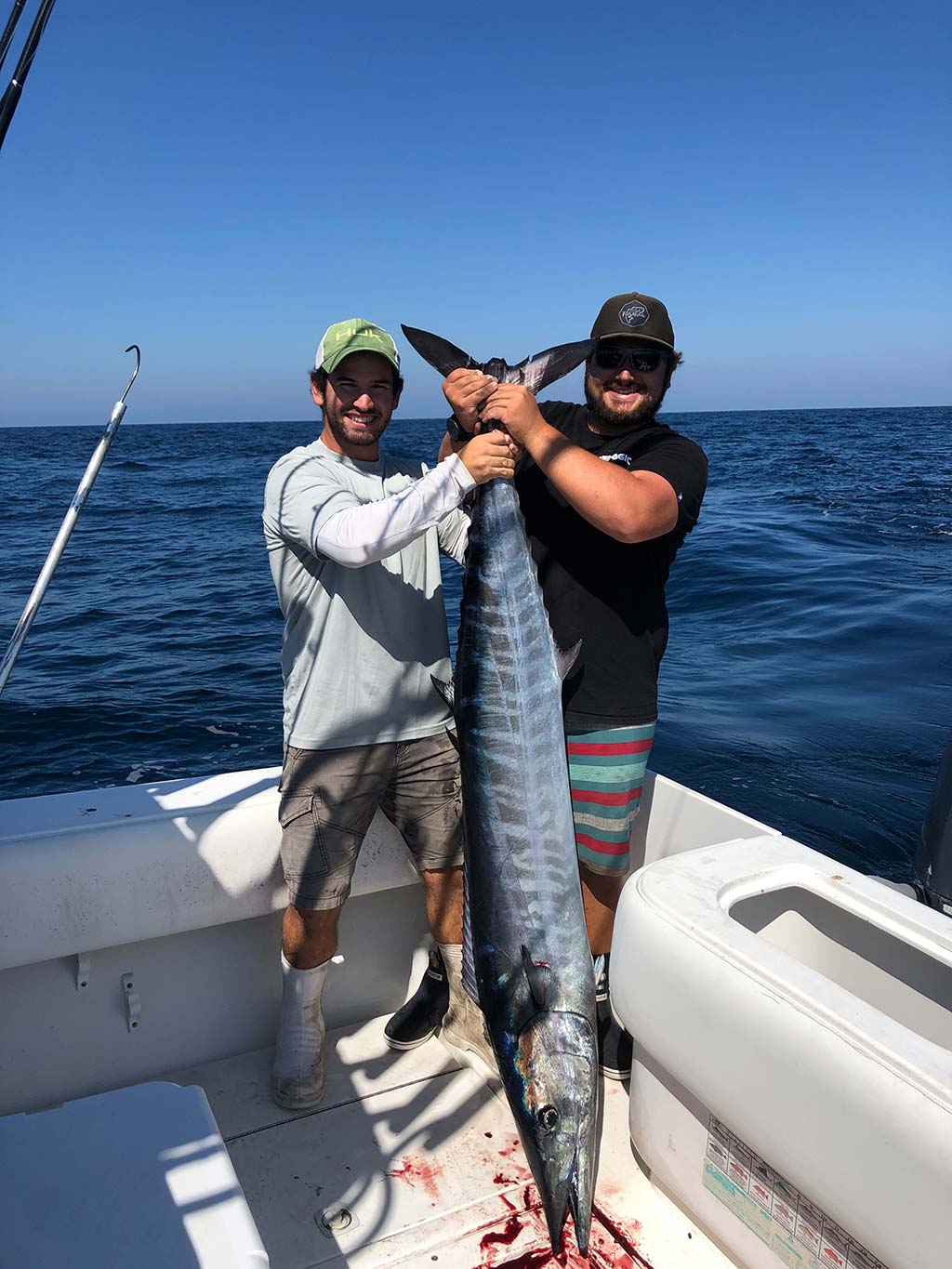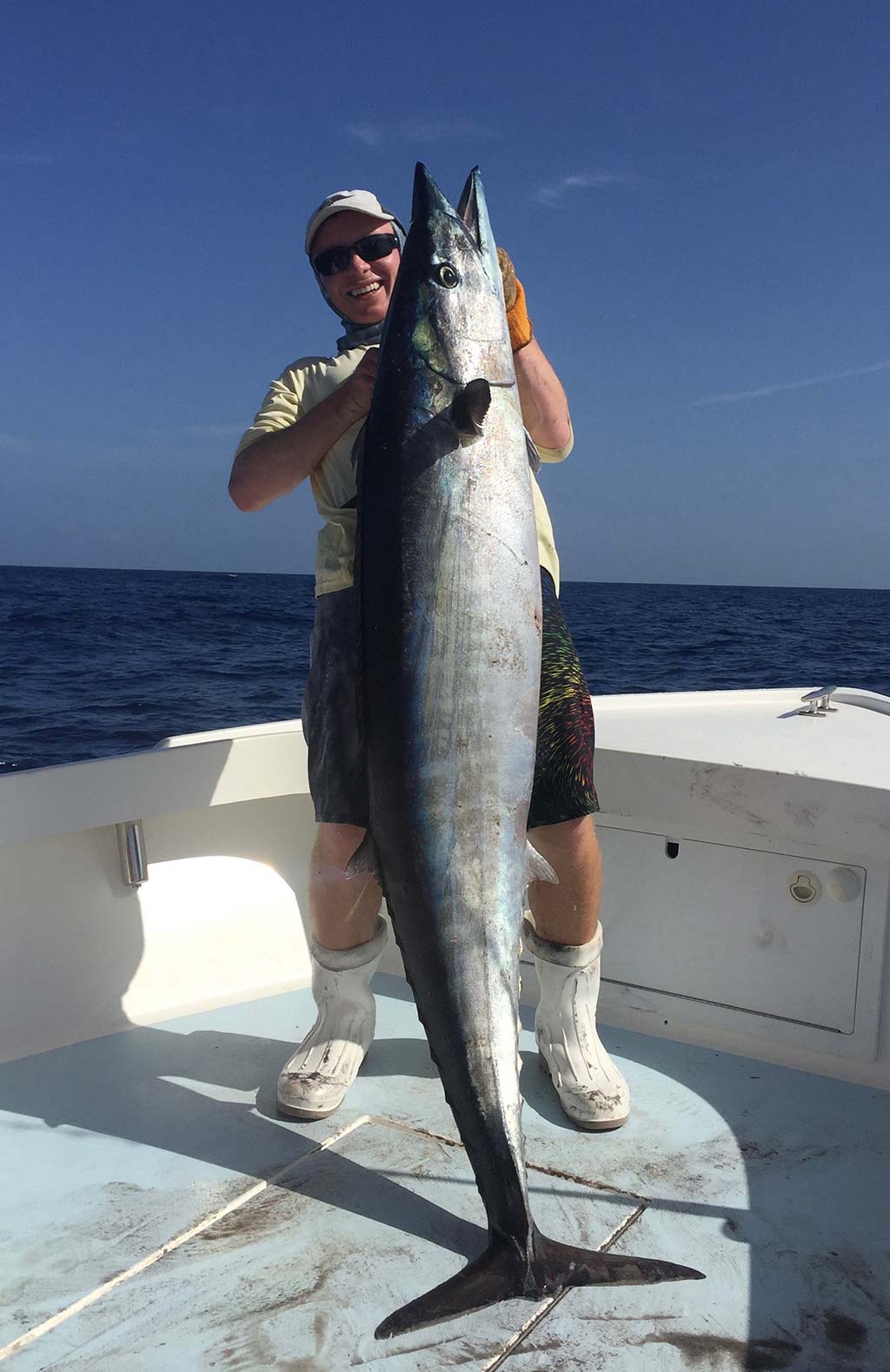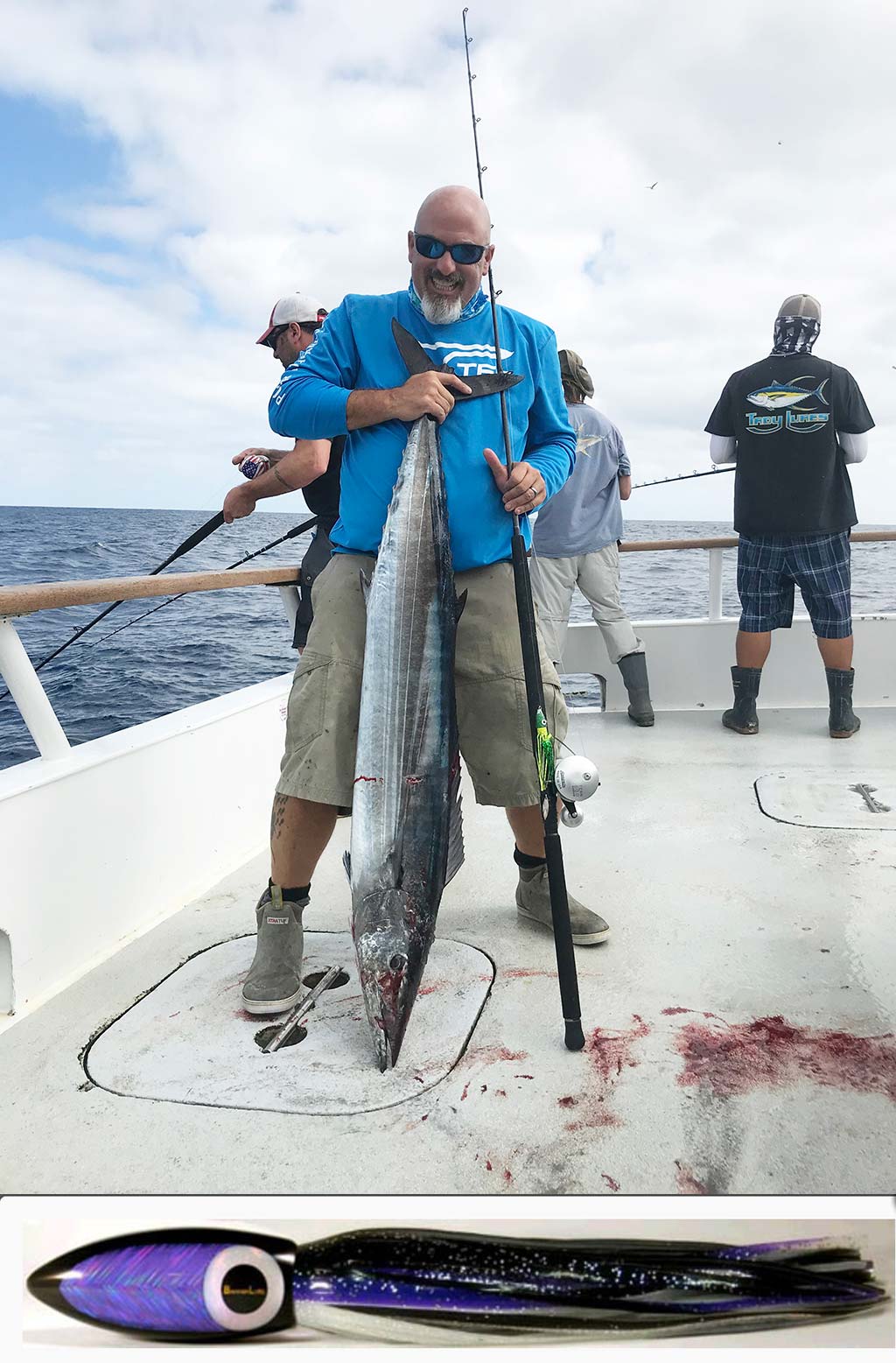
One captain’s successful lesson plan could help others ace their offshore wahoo test.
For most offshore fisherman, wahoo are a very welcomed visitor when targeting the normal tuna, mahi, and marlin. That searing run they take that never seems to end, the electric blue, black, and white coloration, the mouthful of sharp serrated teeth, and the bounty of delicious steaks that comes from them will have anyone begging for more. However, that’s all they seem to be, a visitor.
Well, that’s the case for most anyway. For all of the offshore fishing I have done, I’d been onboard for only one, a 30-pound class fish that ate a way back ballyhoo in Maryland. Other than that, hearing or seeing of one just seemed like a lightning strike. But, for some captains, lightning seemed to strike far more often than it should.
Last summer, myself and a few friends set out to find out how these captains were inducing more wahoo strikes in a season than most guys were seeing in a lifetime.

Research & Development
One of the first things I did was to do some research on the fish itself. Wahoo are a voracious predator, much different than a tuna. They are a fish that travels in solitude, or very small groups, passing through areas as they migrate up and down the Atlantic. They also love structure, think mahi. Lobster pots, buoys, weedlines, dead trees, and any other substantial structure will hold wahoo. In addition, underwater mountains, drop-offs, and any other changes or structures will also hold them.
Wahoo put those slashing teeth to good use, and prefer big prey items. Boohoo mackerel, false albacore, and skipjacks are all prime forage for wahoo, and are a great indicator of their presence. Much like their love for structure, they also love temperature and chlorophyll breaks (water color). Armed with this research, the background profile on these fish is they are fast, aggregate around structure, target big prey, and love breaks.
One of the greatest tools in offshore fishing is being able to learn techniques from guys who have already done it and have tried and true tactics. I started off with Capt. Max Lichtig from West Palm Beach, FL. He spends a lot of time targeting these fish, and while not in Jersey, he had plenty of advice to offer. His recommendation was a three-rod spread and trolling at a rather quick 12 to 14 knots. Two rods would be bent butt outfits out of the corner holders with inline trolling weights, one would be 36-ounce and the other would be 48-ounce. Starting with the 48, he recommended a darker color lure such as black, purple, and red. Once this is ready, get up to trolling speed and let it out for 15 seconds, then engage the reel until the drag would not slip.
Next was the 36; for this one Max recommended a lighter color lure like blue or white, let out for 30 seconds before engaging the reel. This set them out approximately 100 yards and 200 yards back. Finally, the third rod up the middle would be trolled shotgun, or right from the rod tip, with no weight. This one would be let out way, way back, about 250 yards. For the shotgun lure, the Ballyhood Wahoo Express was recommended.
I also spoke with Capt. Darren Dorris of Salty Lady Sportfishing based out of Beach Haven who has quite a few wahoo under his belt, and is the only Garden State captain I know with a specific bag of wahoo tackle. Along with general technique, I thought Darren would have a few top secret wahoo spots to try; or so I thought. I met Darren in Cape May on the day before our trip to pick up the bag as well as his two bent butt setups which were Accurate Valiant 800s, on 30-to 80-pound class rods. Darren recommended a two rod spread of which both would be bent butt outfits with the inline trolling weights and trolling at 12 to 14 knots. Fast? Yes, in fact Darren relates the wahoo to a junkyard dog; if you are walking away from it, he may or may not chase you. If you are running away he’s got no choice, its pure instinct.
As for tackle, he pulled out a lure from the bag that had teeth marks that almost made it unrecognizable. It was a Proteus 50 Bahama Lure in purple and black. This was the must-have lure in the spread, and any other lure in there should be fitted around it. With it being the day before, I was ready to find out the holy grail of wahoo fishing, the top-secret honey hole. There would be no magic LAT/LON numbers however. Wahoo are a travelling fish, here one day and gone the next. Rather than a specific spot, indicators of their presence rule supreme, and are much more useful than a report from a few days ago. Darren gave me a list of spots to try off of South Jersey, areas like The Cigar, The 28 Mile Wreck, Lemke’s Canyon, 30 Fathom Lump, and a slew of other underwater structures that could be holding them.

All Geared Up
It was early September, and we all finally had the day off, with perfect weather, and some rumblings of wahoo being caught. The day before was spent as per usual, rigging, checking connections, and making a game plan. We were leaving out of Townsend Inlet, so we decided to hit the triangle of The Cigar, Lemke’s Canyon, and then the 28 Mile Wreck. Two of our crew, Austin and Colin, had stumbled upon a wahoo two weeks prior while looking for yellowfin not far from the Cigar, so that’s why we would start there.
We opted for a four-rod spread, two with inline weights and two shotgunned way, way back. The two bent butt setups were spooled with 65-pound braid, top-shotted with 80-pound mono, and a ball bearing snap was tied on. An inline trolling weight was than snapped on, followed by 20 feet of 200-pound mono as the shock leader, and then the lure, rigged with 3 feet of 300-pound cable, snapped on. The shotgun rods were a pair of Avet 50EXWs on straight butt 50- to 100-pound class rods filled with 60-pound mono. They simply had a snap tied on followed by the lure snapped on with the same 3 feet of cable.
After clearing the inlet in grey light, we found ourselves at the Cigar at dawn in awful 71-degree green water. We didn’t even go lines in here, green water at that temperature was not what we were looking for, so we continued the trek east towards Lemke’s until we found the water turned cobalt blue and jumped to 76 degrees. We were just a few miles shy of Lemke’s when we were able to check two things off the list, temp/chlorophyll break and the fact that we were coming up on structure. We trolled around right where the break was for about an hour with no luck, and decided to put an effort in for tuna.
We were marking scattered bait and fish, we had great water color and temp, and had seen some porpoise on our original wahoo effort. Austin throttled the boat back to 7 knots and we deployed Chatter tracker bars, daisy chains, cedar plugs, and a variety of other tuna lures. Not very long into our troll we wound up on top of Lemke’s and had our first run off, a small false albacore. For the next hour we played catch and release with about a dozen in the same mile or so area and it was evident we needed to go back on our wahoo effort. Now we had everything we could be looking for, false albies were littered through the area and at times big schools of them were on the surface, we were within a few miles of a temperature break, and we were on the Lemke’s true, a 40-foot decrease in depth at its highest point.

Wahoo On!
We started on Lemke’s true and trolled off the west drop off towards the break with our wahoo spread redeployed. It took all of 10 minutes before one of our shotgun rods, the Ballyhood Wahoo Express to be exact, bent over and line started dumping at an alarming rate. We cleared lines and gradually decreased our speed to about 2 to 3 knots. The reel, originally holding about 600 yards of line, was left with under 100 yards, 250 yards from where we set the lure, and the other 250-plus yards from the runoff. In my life I have never seen a reel empty this quickly!
AJ Wojtusik was first up on the rod and was able to gain back a substantial amount of line. In fear of being too burnt out, he handed the rod off to Austin who was able to finish him off. I grabbed the small gaff anticipating this fish to be about 30 to 40 pounds, making them pretty slender at this size. I was very wrong. Our first look at the fish caused a quick shuffling and I was handed the bigger of the gaffs on the boat. As the end game neared the fish came right up to the boat, exhausted, and I stuck him. Only then did we realize the magnitude of this fish; it was bigger than any of us, at least 6 feet if not more.
When it finally hit the deck we all erupted with cheers. This was a true Jersey wahoo, and a big one at that! After high fives and photos, we quickly deployed the spread again to see if we could get lightning to strike twice – and it did. This time the Proteus went off, and again the reel was almost emptied. Colin jumped on the rod and did it all, start to finish, with another solid fish of about 5 feet in length. Looking back at our GPS, our two hits came within 1/8th of a mile of each other, clearly aggregating around the forage, structure, and preferred water. Later at the dock the first fish of the day weighed in at 70 pounds, the second at 50 pounds.
This trip will stay as one of my most memorable; it doesn’t happen all that often that you get to succeed your first time trying something. Having the help of some wahoo junkies like Max and Darren helped put us where we needed to be and how we needed to do it.
Wahoo fishing in Jersey is a real thing, and can be more than a lightning strike if you put the time and effort in. It’s a fishery where the reward cannot be aptly described; rather, the sound of the reel when the first one hits will do all the talking.


